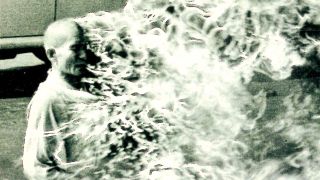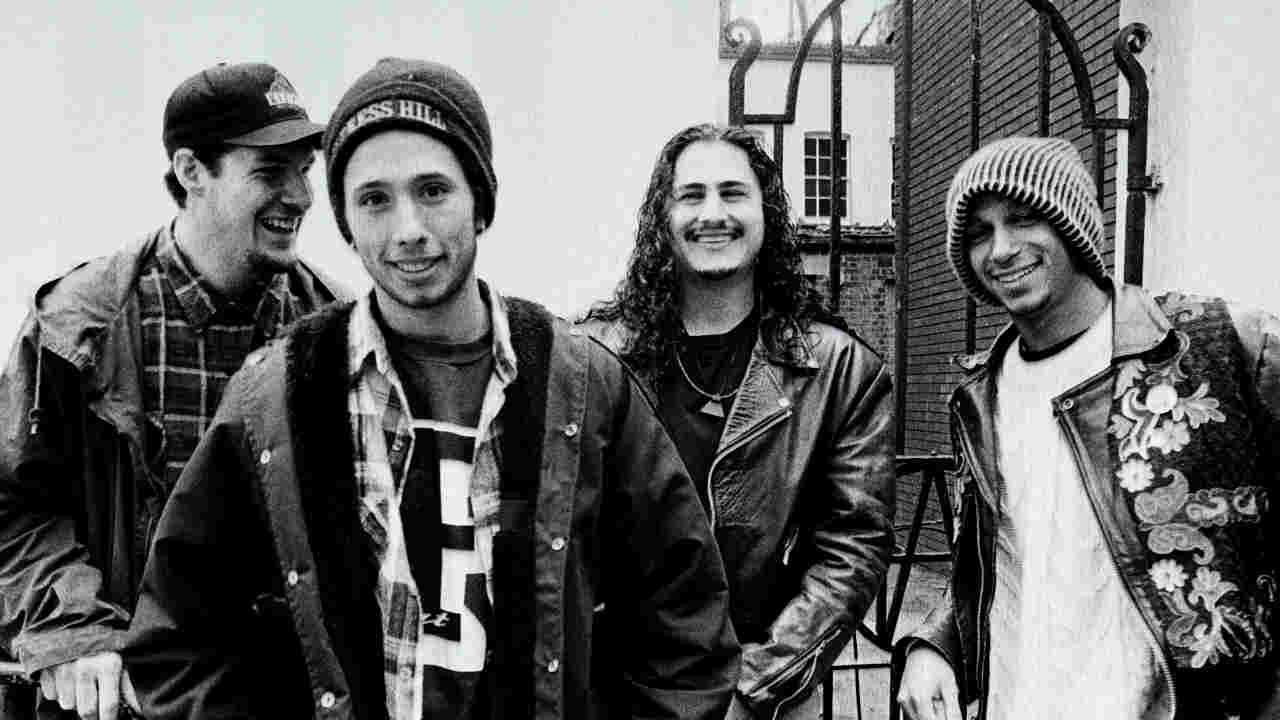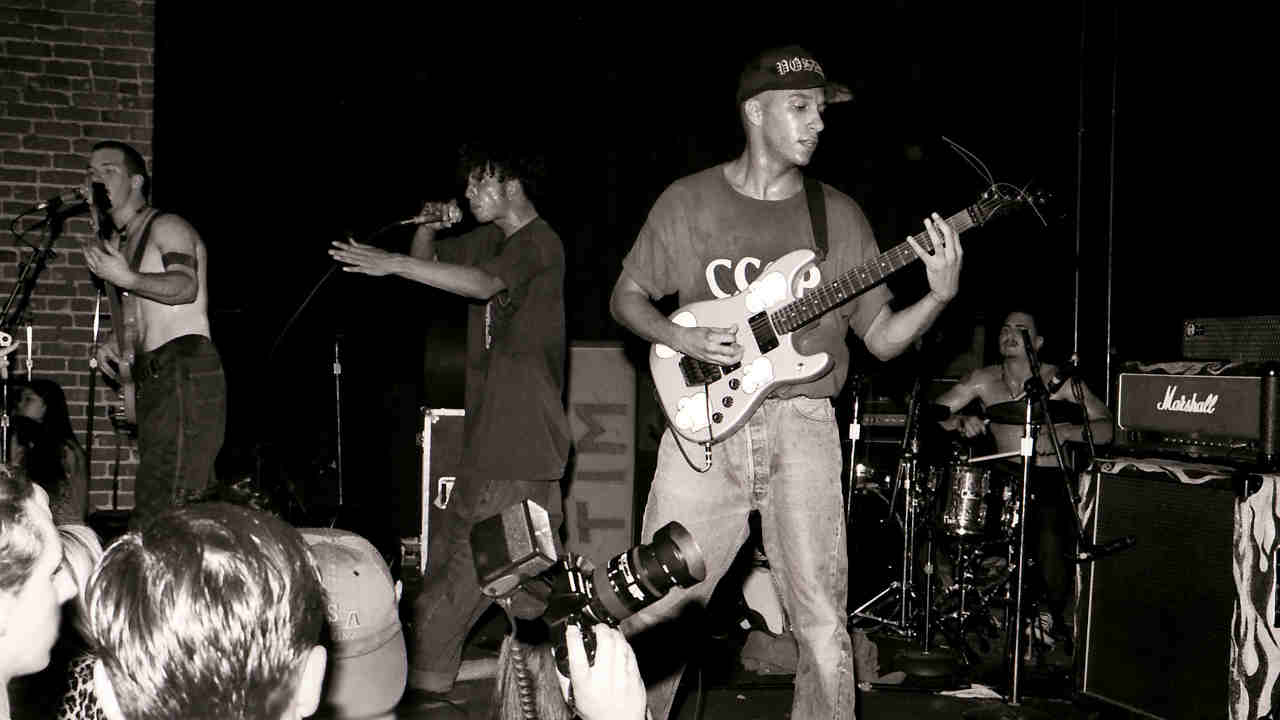Hip Hop Review of Rage Against the Machine
Rage Against The Machine: the explosive debut album that changed the earth

It was early evening on Sunday, February 21, 1993 when the airship went upwards. To the majority of people listening to Radio 1'due south weekly chart rundown, the name Rage Against The Car meant nothing. Why would it? A brand new band mixing metal and hip hop like no one had washed before, they'd yet to make an impact outside of the nation's rock clubs or the stereos of the more clued-in metal fan.
And then, when presenter Bruno Brookes cheerfully announced that their new single, Killing In The Name, had entered the charts at No.27 and cued the vocal upward, neither he nor several meg listeners knew what was near to happen.
The vocal started with a coiled guitar and tense bassline, as some guy rapped about the American law's inherent racism with palpable vitriol in his vocalization: 'Some of those who work forces are the same who burn crosses.' Then – nail! – the whole thing suddenly erupted. Over guitars that sounded like a thousand constabulary sirens wailing all at one time, the line 'Fuck y'all I won't exercise what you tell me!' blasted out of radio speakers everywhere, not only one time, not twice, but 16 times. And and then, of a sudden, information technology reached its gloriously profane crescendo with ane discussion hurled out with all the acrimony and pain that could possibly be mustered: 'MOTHERFUCKER!'
Understandably, the snafu prompted a deluge of complaints to the BBC from offended listeners. Bruno Brookes, who was unaware that an unedited version of the song had accidentally been aired, was suspended for a calendar week and almost lost his job. In just three and a half minutes, a group of political agitators from Los Angeles had detonated an incendiary device live on the airwaves.
"We knew the band'southward politics were radical," says guitarist Tom Morello today. "And that the band'southward music was a radical combination of styles. But we didn't think it was going to affair, 'cos no one was ever going to hear it."
But people did hear information technology, in their millions. Rage Confronting The Machine were about to start a iv-human being revolution.
- Every Rage Against The Machine (and RATM side projection) album ranked from worst to best
- What Really Happened When Zack de la Rocha Quit RATM?
- The x Essential Rap Metallic Albums
- The Story Behind The Song: Anthrax and Public Enemy's Bring The Noise
More than than a quarter of a century after it exploded like a car flop under the hood of mainstream civilization, Rage Confronting The Machine has lost none of its power, impact or provocative fervour. It was the sound of Public Enemy yoked to Blackness Flag, of Dr Martin Luther Rex and Malcolm X set to a soundtrack of cut-edge rap-metal.
Rage arrived as the wilfully shallow, MTV-driven rock scene of the 1980s was flat on the canvas with bluebirds fluttering around its head, laid out by the emergent grunge movement. In America, a new generation of hip hop bands was providing a vital social commentary, marrying the gritty reality of the streets with the vehement glamour of a Hollywood crime blockbuster. All this was happening against a backdrop of global turmoil, racial tension and the threat of war in the Centre Due east. In hindsight, their timing was perfect.
In reality, it was purely accidental. Vocalist Zack de la Rocha, guitarist Tom Morello, bassist Timmy C (aka Tim Commerford) and drummer Brad Wilk had been in various depression-level LA bands, including hardcore firebrands Inside Out (Zack) and Lock Upwards (Tom, who played on their sole anthology, the unfortunately titled Something Bitchin' This Way Comes).
"I had been in a band that had a record deal, I had already had my grab at the contumely ring," says Tom. "The band got dropped and I was 26 years old, and I thought that was it. I thought, 'If I'k non going to be a rock star, or brand albums, I'1000 at least going to play music that I believe in 100%.' And I was fortunate to meet three people who felt very similarly."

The 4 were brought together by diverse mutual friends, though Zack and Tim had known each other since babyhood. Zack and Tom came from similarly radical backgrounds – Zack was the son of Mexican-American political artist Robert de la Rocha, Tom was the son of a white American activist mother and a Kenyan diplomat father. Growing up, both had experienced racism commencement mitt, and bonded over their difficult-left political views – views that would shape Rage from the off.
"I wanted to ensure the protection of this band's integrity," Zack told journalist Ben Myers in 1999. "Our words had to be backed up by actions, because we're dealing with this huge, monstrous pop culture that has a tendency to suck everything that is culturally resistant to it into it in order to pacify it and arrive non-threatening."
Ironically, for a band who would go on to become one of the most successful of the 1990s, Rage Against The Automobile saw their very existence as limiting what they could accomplish.
"We began with zero commercial appetite," says Tom. "I didn't think we'd be able to book a gig in a club, allow alone get a record deal. There was no market for multi-racial, neo-Marxist rap-metallic punk stone bands. That didn't exist. So we made this music that was merely 100% accurate, information technology was 100% what we felt similar playing. We had no expectations."
Still, information technology was clear to the members of Rage from the start that they were onto something unique. Brad Wilk tin can vividly think the band'southward very offset rehearsal.
"More than anything, I remember this connection and movement and momentum that was happening in the room," he says. "Something clicked. I played so well with Tim and Tom, and then we had Zack, who was a bolt of lightning, flying off my boot pulsate and was in it for real. There was something actually special virtually what we were doing. We weren't analysing it or putting our fingers on information technology nevertheless. It was just an intense moment for us all. We saw the very beginning of the potential we could have."
Like so many Californian bands before them, Rage's starting time gig took place not at a society but at a political party, in Huntington Beach, in the sprawling suburb of Orangish County, south of Los Angeles.
"It was a political party in a business firm, and the place felt electric," says Tim Commerford. "A lot of our songs didn't even take vocals at that time. In fact, we played a version of Killing In The Name that was just the music – he hadn't got the vocals done. You could feel the electricity. It felt similar holding on to a fucking live wire. That's what it was: a live wire. And it kept getting more and more alive."
Collectively, Rage were fans of hip hop, and Tom recalls the band's early days beingness sound- tracked by the likes of Public Enemy and Cypress Colina. But while hip hop provided a big steer for the band, it wasn't their sole influence. All four had grown up on guitar music ranging from 70s stone and 80s metal to punk.
"Our histories run deep, that'due south why nosotros were the band we were," says Brad. "We didn't only mind to hip hop, we listened to all kinds of things, from Blackness Sabbath to Led Zeppelin to Minor Threat and the Sexual activity Pistols. When nosotros were getting together, we agreed that nosotros wanted our record to sound somewhere between Ice Cube'south AmeriKKKa's Most Wanted and Led Zeppelin'due south Houses Of The Holy."
In March, Rage embarked on their first proper bout as openers for Public Enemy. Thanks to the controversies whipped up by the Usa media around 'gangsta rap' acts such every bit NWA and Ice-T, mainstream America had a poisonous – read: virulently racist – human relationship with hip hop, and trouble was never far away. It was the perfect environment for Rage Confronting The Machine.
"The tour was a needlessly controversial i," says Tom. "At the time, rap was considered a unsafe endeavour, and the police sometimes outnumbered the audience at these shows. They tried to close several downwards, filed injunctions – none of which were successful, I might add. We were playing these colleges, and the audition would exist 100% white fraternity boys and sorority girls, passing through five levels of metal detectors and pat-downs. I think the cops were afraid that we were going to be bussing in Bloods and Crips to the testify. There was an air of hysteria."
Today, the guitarist nevertheless expresses bafflement that anyone at all would want to gamble on Rage Against Their Car and their political message, let lonely a corporate record company. Just their 12-track demo tape found its way into the hands of Michael Goldstone, the Epic Records A&R hotshot who'd previously signed Pearl Jam.
"Our only goal was to make music for ourselves and to brand our own record – a cassette record, an elaborate demo record of the 12 songs nosotros had written," says Tom. "That was our entire goal. We never thought nosotros'd play a show. We never thought we'd make a record."
Garth Richardson was a immature Canadian studio engineer whose biggest credit came on an album by hair metallic B-listers White King of beasts. Simply he was young and hungry, and when Epic asked his boss, producer Michael Wagener, who should work on the debut album past this hot new rap-metal band they had signed, he was an obvious choice.
"I got the demo tape and went, 'Holy shit.' There was nothing else like information technology," he recalls. "I went over to see them play in their jam space. I think they played me four songs, and I was blown away, to the point where I couldn't talk subsequently, because my stutter was so bad. I was similar, 'Are you fucking kidding me – I'm going to be doing this band?' It was their power, and likewise what Zack was saying. It was and then fresh and and so new."
Rage began recording their debut album with Garth in March 1992. Seven of the 12 tracks from the demo tape, including Killing In The Name, Bomb Rail and Bullet In The Caput, would appear on the anthology.
"The songs were probably about 85 to ninety% there," remembers Garth. We made a few changes, mostly lyrically. Literally, somebody simply had to capture them."
To attain this, the producer brought in a full concert PA arrangement to get the full impact of the band's live firepower. This was undiluted Rage – though sometimes it created unforeseen issues.

"The problem is that sometimes Zack'due south voice went," says Garth. "He was working it then hard. The end of Liberty, where he'south screaming, 'Freedom!', that's merely one accept. Every fourth dimension he sang, he gave it his all. Anybody that wanted him to hold back, he was, similar, 'No, fuck off, exit me alone.'"
Given the incendiary lyrical subject matter, at that place was surprisingly little input from Epic. They seemed to larn their lesson after suggesting the band remove the line 'Now you're under control' from Killing In The Proper name. "There was a big chat about that," remembers Garth. "And the band just said, 'Fuck y'all, that part stays.'"
Killing In The Name would be the song that bankrupt the band in the U.k.. For six months, it soundtracked every rock club in the country, its impassioned call-to-artillery galvanising dancefloors of people out to party. Even so, like so many of the great songs, it came well-nigh by accident.
"I remember coming up with that riff," says Tom. "I was giving guitar lessons at the time, and I was teaching some Hollywood rock musician how to do drop-D tuning. In the midst of showing him, I came up with that riff. I said, 'Hold on a 2nd', and I recorded it on my little cassette recorder to bring into the rehearsal the side by side solar day, never realising that information technology would exist the genesis of a song that would have that lasting touch on."
In April 1992, a series of riots erupted in Los Angeles when 4 white policemen were acquitted of beating African-American motorist Rodney Rex, despite the assault being filmed by a witness standing on his balcony. For America, it was a moment of chaos. For Rage Against The Automobile, who had already recorded their debut album and would release it in November, the timing was unfortunately convenient.
"All of those songs were written prior to the Rodney King riots," says Tom. "In some ways the record was prescient, in that it saw this maelstrom of racial strife and imperialist state of war on the horizon. When the record hit, it was a fertile field for us to accept the ear of audiences effectually the globe."
Rage were proudly revolutionary – too revolutionary for America, who were slow to catch on. Britain was a different affair, as Bruno Brookes' unfortunate Radio 1 mishap proved.
"The UK was the first place people lost their minds over this music," says Tom. "Ane of the chief reasons was that there were more lax lyrical censorship laws on your MTV and radio. We never edited the curse words out of songs, then people in the United States couldn't even hear them on MTV, they couldn't hear them on radio. And secondly, people over at that place were surprised to hear an American band that had a view of America that was like to Europe's view of America."
From that small spark, a conflagration began to spread, equally word virtually Rage Confronting The Machine grew. Their snowballing success had the desired effect, equally a generation – or at least sections of information technology – began to wake upwards to the messages they were delivering through the bullhorn of their songs. Musically, too, they dragged the dormant rap-metal movement that had briefly flared upwards in the tardily 1980s back out of its stupor (in Bakersfield, California, the members of a brand new ring named Korn were certainly paying attention to what Rage were doing).
Plus, gild was irresolute fast in the early 90s. While sexism, racism and homophobia were still unfortunately prevalent, there was growing opposition to such outdated outlooks. Rage Against The Machine took it several steps farther, crediting Black Panthers founder Huey Newton and Conditional IRA hunger striker Bobby Sands on the credits list to their album – a contentious move on both sides of the Atlantic. The sleeve itself featured a 1963 pic of Vietnamese monk Thich Quang Duc setting himself on burn in protest of his authorities's oppression of Buddhism. Information technology was the ultimate visual representation of protest.
"My heroes were not guys in rock bands," says Tom. "They were revolutionaries who were fighting to change the world. It looked like we were going to take an opportunity to get in that arena. This was an incredible opportunity to engage the planet – not but with our music, but with our ideas."
The success of Rage Against The Machine took everyone by surprise, not least Rage Against The Machine. They quickly went from being the outcasts of the Hollywood scene to a lightning rod for the alt-stone movement. Rather than blunting their political border, success but sharpened it – most famously in 1993, when they took to the phase at a Lollapallooza festival evidence in Philadelphia naked, apart from gaffa tape over their mouths, equally a protest against censorship.
But the pressure-cooker surround that comes with being in a revolutionary left-wing band somewhen took its toll. Tensions betwixt the bandmembers grew, and Rage split up in 2000 later just three studio albums. They have sporadically reformed since – virtually famously for a one-off gig in London's Finsbury Park, after a fan-led campaign saw a reissued Killing In The Name beat out the Simon Cowell-backed X-Cistron winner Joe McElderry to the 2009 Christmas No.1.
More than than 25 years afterward it was released, Rage'due south debut remains a landmark – the point where rap and metal truly came together to deliver a body-blow to the condition quo.
"Human strife has not changed. Racism has not inverse. Things have really gone backwards," says Garth Richardson. "Rage Against The Motorcar wrote an incredible tape that was electric current – and it will be fourth dimension and time and time once again."
Source: https://www.loudersound.com/features/we-were-a-f-king-livewire-25-years-of-rage-against-the-machine
0 Response to "Hip Hop Review of Rage Against the Machine"
Post a Comment